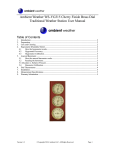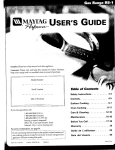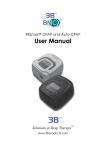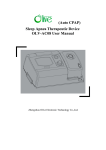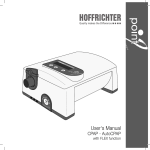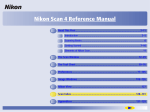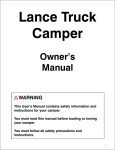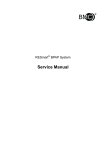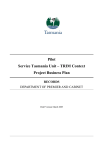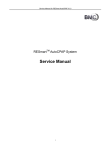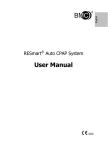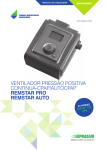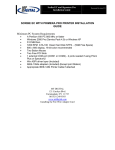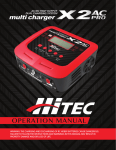Download RESmart® Auto-CPAP
Transcript
RESmart® Auto-CPAP CLINICIAN’S MANUAL RESmart® Auto-CPAP CLINICIAN’S MANUAL RESmart® Auto-CPAP Indications for Use ® CLINICIAN’S MANUAL Indications for Use ® The RESmart APAP system is a CPAP (Continuous Positive device The RESmart APAPAirway systemPressure) is a CPAP (Continuous Positive Airway Pres ® designed for the treatment of adult Obstructive Sleep Apnea (OSA) only. RESmart has Sleep Apnea (OSA) only. R designed for the treatment of adult Obstructive three treatment modes: Auto, Titrate and fixed-pressure CPAP. three treatment modes: Auto, Titrate and fixed-pressure CPAP. ® The RESmart® APAP is to be used only The on the instruction of ais licensed health RESmart APAP to be used onlycare on the instruction of a licensed professional. Your home care provider will professional. make the correct settings according Your pressure home care provider will make the correct pressure settin to your health care professional’s prescription. to your health care professional’s prescription. ® ® Several accessories are available to make your accessories OSA treatment with the RESmart are(Continuous available to make your OSA treatment with thd The RESmart APAP Several system is a CPAP Positive Airway Pressure) AutoCPAP system as convenient and comfortable as possible. Toconvenient ensure thatand youcomfortable receive AutoCPAP system as as possible. To ensure tha designed for the treatment of adult Obstructive Sleep Apnea (OSA) only. RESmar the safe, effective therapy prescribed for you, only BMC accessories. theuse safe, effective therapy prescribed for you, use only BMC accessories. Indications for Use three treatment modes: Auto, Titrate and fixed-pressure CPAP. ® the entire user manual before operating this system. If you have IMPORTANT!The Read RESmart and understand APAP IMPORTANT! is to be used on thetheinstruction of before a licensed health Readonly and understand entire user manual operating this syste any questions concerning the use of this system, contact your home care provider or health care any questions concerning the use of this system, contact your home care provider or health professional. Your home care provider will make the correct pressure settings acc professional. professional. to your health care professional’s prescription. Contraindications Contraindications Several accessories are available to make your OSA treatment with the RES ® ® The RESmart AutoCPAP APAP is notsystem a life support device and and may stopisoperating with power The RESmart APAP not a lifeas support deviceTo and may stop as convenient comfortable possible. ensure thatoperating you re failure or certain fault conditions. It should not be used by patients who are dependent onbe used by patients who are d failure or certain fault conditions. It should not the safe, effective therapy prescribed for you, use only BMC accessories. 3B Medical, Inc. 1142 N. Scenic Highway Lake Wales, FL 33844 USA Email: [email protected] Tel: (863) 226-6285 Fax: (863) 226-6284 continuous therapy. continuous therapy. Positive airway pressure therapy may bePositive contraindicated in sometherapy patientsmay withbethe airway pressure contraindicated in some patie IMPORTANT! understand the entire user manual before operating this system. If you following pre-existing conditions: Read and following pre-existing conditions: • Bullous Lung any Disease • Bullous Diseasecontact your home care provider or health care questions concerning the use ofLung this system, • Bypassed Upper Airway • Bypassed Upper Airway professional. • Pneumothorax • Pneumothorax • Pathologically Low Blood Pressure • Pathologically Low Blood Pressure • Pneumocephalus has been reported in a patient using nasal Continuous PositiveinAirway • Pneumocephalus has been reported a patient using nasal Continuous Po ® when prescribing CPAP for susceptible patients such Pressure. Caution be used should bedevice used when CPAP for susceptible Theshould RESmart APAP Pressure. is not aCaution life support andprescribing may stop operating with p Contraindications RESmart® AutoCPAP Clinician’s Manual RESmart® Auto-CPAP CLINICIAN’S MANUAL Indications for Use The RESmart® APAP system is a CPAP (Continuous Positive Airway Pressure) device designed for the treatment of adult Obstructive Sleep Apnea (OSA) only. RESmart® has three treatment modes: Auto, Titrate and fixed-pressure CPAP. The RESmart® APAP is to be used only on the instruction of a licensed health care professional. Your home care provider will make the correct pressure settings according to your health care professional’s prescription. Several accessories are available to make your OSA treatment with the RESmart® AutoCPAP system as convenient and comfortable as possible. To ensure that you receive the safe, effective therapy prescribed for you, use only BMC accessories are recommended. IMPORTANT! Read and understand the entire user manual before operating this system. If you have any questions concerning the use of this system, contact your home care provider or health care professional. Contraindications The RESmart® APAP is not a life support device and may stop operating with power failure or certain fault conditions. It should not be used by patients who are dependent on continuous therapy. Positive airway pressure therapy may be contraindicated in some patients with the following pre-existing conditions: • Bullous Lung Disease • Bypassed Upper Airway • Pneumothorax • Pathologically Low Blood Pressure • Pneumocephalus has been reported in a patient using nasal Continuous Positive Airway Pressure. Caution should be used when prescribing CPAP for susceptible patients such as those with: cerebral spinal fluid leaks, abnormalities of the cribriform plate, prior history of head trauma, and/or pneumocephalus. (Chest 1989; 96:1425-1426) • The use of positive airway pressure therapy may be temporarily contraindicated if you exhibit signs of a sinus or middle ear infection. Contact your health care professional if you have any questions concerning your therapy. Sensitivity The speed of pressure adjustment can be modified to improve patient comfort. A lower sensitivity setting corresponds to a more gradual pressure adjustment. The higher the sensitivity setting the faster the speed of pressure adjustment. For example, at a Sensitivity setting of 5, the higher the speed of pressure adjustment (increasing or decreasing). When respirations increases rapidly and suddenly, as during waking, the treatment pressure decreases rapidly for patient comfort. Definitions Avg. Daily Compliance (H:M): Average time of patient use of the device in nightly therapy Average P95 (cmH20): Auto pressure at or below the pressure 95-percent of that it is in use Mean Pressure (cmH20): The mean pressure level, in hPa, delivered within the selected range AHI: Apnea/Hypopnea Index (AHI), represents the average number of the apnea and hypopnea per hour for the timeframe SNI: Snore Index (SNI), represents the mean snore count per hour Adverse Effects Patients should report unusual chest pain, severe headache or increased breathlessness to their prescribing physician. An acute upper respiratory tract infection may require temporary discontinuation of treatment. 2 7 RESmart® AutoCPAP Clinician’s Manual When treatment pressure approaches 10hPa(cmH2O) during rising, not only rising speed CHANGING DEVICE SETTINGS will decrease greatly but also snore or flow limitation must be detected for increasing Topressure. enter theThis clinician’s mode an forinappropriate the device, remove thetopower from the RESmart unit. is to prevent response centralcord apneas. Press and hold both the start and ramp buttons simultaneously, while reconnecting the power Snore cord. The RESmart unit may now be programmed with therapy options. When a patient snores, sound is generated and the inspiratory flow/time curve is distorted ® by may the step frequency theof the sound. RESmart calculates snore To level You through of each options using thedetects + and - and buttons on the device. change a breath-by-breath. setting, press the When ramp button. your setting by pressing ramp than a second time. snore Confirm sound intensity exceeds 50% higher background noise, then one snoring event is scored. Treatment pressure increases after continuing 3 Setting options include: snores. The rising speed is inverse proportion to current pressure, namely the higher current pressure the lower rising speed. Mode: CPAP, Titrate, or Auto Snore (SNI), the mean snore count per hour. Treat P:Index set therepresents treament pressure Snore Level set is index for degreetreatment of patient pressure snoring. It is the percentage of all breathes with Max APAP: the maximum Ramp: Set For rampexample, time from20% starting pressure to treatment in minutes. snoring event. means 20 breathe along pressure, with snoring in all 100 breathes. Default time is 10 minutes Init P: set the starting ramp pressure. Default setting is 4.5 cmH20 Flow Limitation Unit: cmH20 or hPa Flow Limitation is thehours partialofairway closure without snore. As the upper airway begins to Use time: Useage the device collapse, Mask test: the shape of the inspiratory flow/time curve changes and the central section flattens. RESmart® analyzes the curve shape of each breath and calculates the distortion. Important: to save settings you must advance through all setting options untilLimitation you Flow Limitation usually precedes snoring and obstruction. Detection of Flow encounter the “Save?” prompt. Hit ramp to confirm settings. enables the device to increase the pressure before obstruction occurs, making treatment pre-emptive. This is also the important criterion for obstruction and central apnea. Hypopnea A hypopnea is defined as a 60-80% decrease in ventilation. After scores 6 hypopneas within 3 minutes, treatment pressure will rise. RESmart® AutoCPAP Clinician’s Manual The following side effects may arise during the course of therapy with the RESmart® device: • Drying of the nose, mouth or throat • Nosebleed • Bloating • Ear or sinus discomfort • Eye irritation • Skin rashes • Chest discomfort. Auto Mode The treatment pressure required by the patient may vary through the night, and from night to night, due to changes in sleep states, body position, and airway resistance. RESmart® provides only sufficient pressure to maintain upper airway patency. You can set the initial and maximum allowable treatment pressures. RESmart® analyzes the state of the patient’s upper airway on a breath-by-breath basis and delivers pressure within the allowed range according to the degree of obstruction. Auto Mode improves patient compliance through enhanced algorithm of Auto Mode. AutoSet algorithm auto-adjusts to maintain optimal therapy pressure. The pressure can vary from treat pressure (Treat P) to maximum treat pressure (Max APAP), which is shown as below: Titrate Mode For the previous Auto Mode of APAP, after Ramp time, the pressure will increase from "Init P" to "Treat P". Once respiratory events appear, the treatment pressure increases; if there is no occurrence of respiratory events, the treatment pressure drops. The pressure range: the minimum is “Init P” and the maximum is “Max APAP”. Pressure Adjustment of the Titrate Mode is shown as below: Pressure change in Titrate Mode When treatment pressure is rising, if current pressure is lower than Treat P, the rising 6 RESmart® Auto Pressure adjusts treatment pressure as a function of four parameters: Apnea, Snore, Flow Limitation, and Hypopnea. Apnea An apnea is defined as a greater than 80% decrease in ventilation. After scores 2 apneas within 3 minutes, treatment pressure will rise. The rising speed is inverse proportion to current pressure, namely the higher current pressure the lower rising speed. Treatment pressure stops rising when normal ventilation and no snore. If ventilation keeps normal for several minutes, treatment pressure will decrease. The descending speed is direct proportion to current pressure, namely the higher current pressure the higher descending speed. 3 RESmart® AutoCPAP Clinician’s Manual RESmart® AutoCPAP Clinician’s Manual When treatment pressure approaches 10hPa(cmH2O) during rising, not only rising speed will decrease greatly but also snore or flow limitation must be detected for increasing pressure. This is to prevent an inappropriate response to central apneas. Snore When a patient snores, sound is generated and the inspiratory flow/time curve is distorted by the frequency of the sound. RESmart® detects and calculates snore level breath-by-breath. When snore sound intensity exceeds 50% higher than background noise, then one snoring event is scored. Treatment pressure increases after continuing 3 snores. The rising speed is inverse proportion to current pressure, namely the higher current pressure the lower rising speed. Snore Index (SNI), represents the mean snore count per hour. Snore Level is index for degree of patient snoring. It is the percentage of all breathes with snoring event. For example, 20% means 20 breathe along with snoring in all 100 breathes. Flow Limitation Flow Limitation is the partial airway closure without snore. As the upper airway begins to collapse, the shape of the inspiratory flow/time curve changes and the central section flattens. RESmart® analyzes the curve shape of each breath and calculates the distortion. Flow Limitation usually precedes snoring and obstruction. Detection of Flow Limitation enables the device to increase the pressure before obstruction occurs, making treatment pre-emptive. This is also the important criterion for obstruction and central apnea. Hypopnea A hypopnea is defined as a 60-80% decrease in ventilation. After scores 6 hypopneas within 3 minutes, treatment pressure will rise. speed is doubled. If current pressure is higher than Treat P, the rising speed is normal (as Auto mode). Contrarily, when treatment pressure is decreasing, if current pressure is lower than Treat P, the decreasing speed is normal. If current pressure is higher than Treat P, the decreasing speed is doubled. Titrate Mode For the previous Auto Mode of APAP, after Ramp time, the pressure will increase from "Init P" to "Treat P". Once respiratory events appear, the treatment pressure increases; if there is no occurrence of respiratory events, the treatment pressure drops. The pressure range: the minimum is “Init P” and the maximum is “Max APAP”. Pressure Adjustment of the Titrate Mode is shown as below: Pressure change in Titrate Mode When treatment pressure is rising, if current pressure is lower than Treat P, the rising 4 Significance of Auto and Titrate Mode The Titrate Mode is based on manual titration and its algorithm is sensitive to respiratory events. Advantages: it can decrease AHI effectively and compute the P95 pressure accurately. Disadvantages: it has large pressure range, the pressure changing is easy to cause the patient discomfort. The APAP combines the Titrate Mode with new Auto Mode to effectively adjust the pressure for maximum comfort, with the premise of effective treatment. To get a accurate P95 pressure, Titrate Mode is applicable for the first 1-2 weeks during the use. Based on the P95 pressure, MAX APAP is determined. It is suggested to set the MAX APAP little higher(1or 2 cm H2O) than P95 pressure. And based on the Pmean pressure, Treat P is determined. It is suggested to set the Treat P little lower(1or 2 cm H2O) than Pmean pressure. It can improve patient’s compliance with more accurate and humane pressure range. RESlex® In Auto mode, you can select expiratory pressure relief (RESlex®). RESlex® is designed to maintain optimal treatment pressure for the patient during inhalation and reduce the delivered mask pressure during exhalation. The desired result of RESlex is to decrease the pressure the patient must breathe out against, making the overall therapy more comfortable. The features of RESlex® are: • RESlex® is disabled automatically in the event of an apnoea. • RESlex® resumes automatically when the apnoea event has passed. • You can select a RESlex® pressure drop of 0, 1, 2 or 3 (maximum drop is 3 cm H2O). • Pressure drop is limited, to avoid sub-optimal treatment. • When RESlex® is enabled, the delivered pressure will not drop below a minimum pressure of 4 cm H2O. 5





